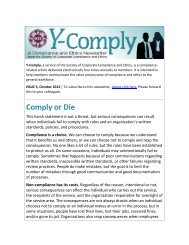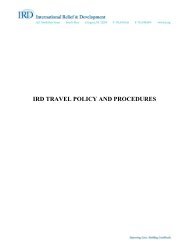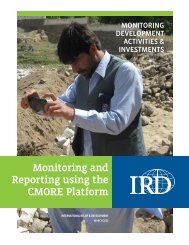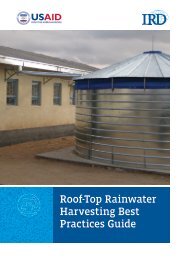IRD Vehicle Policy - International Relief & Development
IRD Vehicle Policy - International Relief & Development
IRD Vehicle Policy - International Relief & Development
Create successful ePaper yourself
Turn your PDF publications into a flip-book with our unique Google optimized e-Paper software.
Title: <strong>Vehicle</strong> <strong>Policy</strong> Effective Date: 11/22/10<br />
11. If vehicle and personal belongings are searched, watch closely to ensure nothing is stolen or<br />
planted in the vehicle.<br />
12. As you pass through any checkpoint, keep a reasonable distance between vehicles so that if one<br />
vehicle encounters problems, others may escape or call for help via radio.<br />
NOTE: Do not leave the planned path or roadways. Driving off road increases the possibility of<br />
encountering mines, unexploded ordnance and criminal activity. Leaving the planned path<br />
makes it more difficult to find you.<br />
NOTE: If journeys are repetitive, vary the routes (if possible). Routine routes increase the<br />
chance for victimization.<br />
NOTE: It is up to the CD/COP whether or not to institute the two-vehicle rule e.g. in certain<br />
difficult areas, travel can only be undertaken with a minimum of two vehicles traveling<br />
together.<br />
J. Convoys<br />
Prior to arranging convoys, one must consider the image and target of opportunity projected by<br />
several high value vehicles traveling together, carrying loads of expensive commodities and<br />
driven by healthy, well-dressed persons and/or foreigners. It may be safer to break the convoy<br />
into smaller segments.<br />
1. If convoys are used:<br />
a. Limit the size of the convoy to no more than eight vehicles.<br />
b. Determine a convoy leader.<br />
c. Check with local authorities to see if special permission is necessary to travel in this<br />
manner.<br />
d. If possible, reconnoiter the route(s) prior to departure.<br />
e. Prepare contingency plans:<br />
<br />
<br />
Determine what to do in the event one vehicle breaks down.<br />
Never leave a person over night with the vehicle.<br />
Consider abandoning the vehicle and any goods that cannot be switched to another<br />
vehicle.<br />
f. Do not travel after dark.<br />
g. File a journey plan.<br />
h. Decide on the position of each vehicle in the convoy.<br />
<br />
<br />
<br />
<br />
Place slower vehicles in the front of the convoy.<br />
Place one radio equipped vehicle in the front (second position) and one in the back<br />
(next to last). If only one vehicle is radio equipped, place it in the back.<br />
Medical units, if included, should be placed towards the middle or rear.<br />
<strong>Vehicle</strong>s carrying spare parts should go in the middle or back of the convoy.<br />
Notice: A printed copy of this document may not be the latest version.<br />
Available online: https://portal.ird.org<br />
Updated: April 2012 16


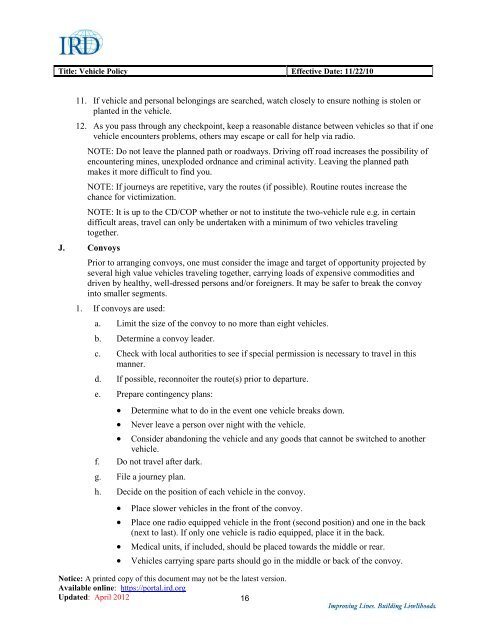
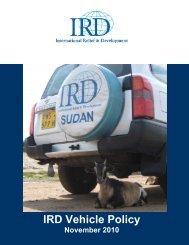
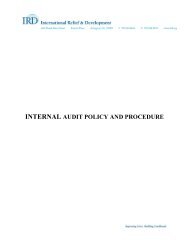
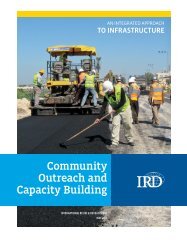
![Guide bonne pratique production d'oignon qualité_VF_4_2411012[1]](https://img.yumpu.com/23506639/1/184x260/guide-bonne-pratique-production-doignon-qualitac-vf-4-24110121.jpg?quality=85)

